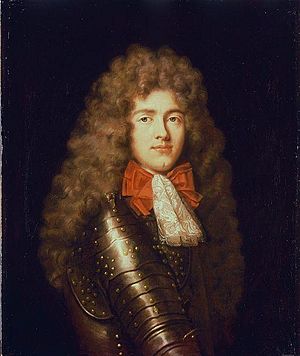William Gandy facts for kids
William Gandy (died 1729) was a skilled English portrait painter. He was known for his unique style and for inspiring other famous artists.
Contents
William Gandy's Life and Art
William Gandy was the son of another painter, James Gandy. He was likely born in Ireland. For many years, he traveled around as a painter in places like Devon and the west of England. In 1714, he moved to Plymouth. Later, he settled down in the city of Exeter.
Gandy's Personality and Work Habits
People who knew Gandy said he had a strong personality. He was very proud and could be easily upset. As he got older, he became a bit lazy and enjoyed a comfortable life. He didn't always care much about his reputation as a painter. If something bothered him during a job, he might not put his full effort into the painting.
Gandy liked to tell people he was the secret son of a powerful person, the Duke of Ormonde. He even hinted that he was too involved in the Duke's business to show his face in London.
His Artistic Talent and Influence
Even though some of his portraits were quick sketches, they showed real artistic genius. Many great artists admired his work. For example, a portrait he painted of the Rev. Tobias Langdon in Exeter College was highly praised by Sir Godfrey Kneller, another famous painter.
Gandy also played a big part in helping the young Sir Joshua Reynolds develop his talent. Reynolds, who became one of England's most important painters, saw Gandy's pictures when he was young. They made a strong impression on him. Like another artist named Northcote, Reynolds often borrowed one of Gandy's portraits, probably the Langdon one, to study it closely.
Notable Portraits by Gandy
William Gandy painted many important people of his time. Some of his subjects included Northcote's grandmother and several religious leaders like the Rev. Nathaniel Harding and the Rev. John Gilbert. He also painted John Patch, a surgeon, and the Rev. William Musgrave. Other notable portraits were of Sir Edward Seaward, Sir Richard Pyne (a judge in Ireland), and Sir William Elwill. Gandy often started paintings but sometimes left them for other artists to finish.
He died in Exeter and was buried at St. Paul's Church on July 14, 1729.


